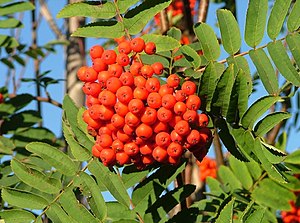Difference between revisions of "Rowan"
Jump to navigation
Jump to search
m (1 revision: From PNW foraging book - part 2) |
(cut down) |
||
| Line 1: | Line 1: | ||
| − | |||
{{Automatic taxobox | {{Automatic taxobox | ||
| image = Rowanberries in late August 2004 in Helsinki.jpg | | image = Rowanberries in late August 2004 in Helsinki.jpg | ||
| Line 9: | Line 8: | ||
}} | }} | ||
| − | + | '''Rowans''' or '''mountain-ashes''' | |
| − | |||
| − | |||
| − | |||
| − | |||
| − | |||
| − | |||
| − | |||
| − | |||
| − | |||
| − | |||
| − | |||
| − | |||
| − | |||
| − | |||
| − | |||
| − | |||
| − | |||
| − | |||
| − | |||
| − | |||
| − | |||
| − | |||
| − | |||
| − | |||
| − | |||
| − | |||
| − | |||
| − | |||
| − | |||
| − | |||
| − | |||
| − | |||
| − | |||
| − | |||
| − | |||
| − | |||
| − | |||
==Selected species== | ==Selected species== | ||
| Line 106: | Line 68: | ||
*''[[Sorbus wilfordii]]'' | *''[[Sorbus wilfordii]]'' | ||
{{div col end}} | {{div col end}} | ||
| − | |||
| − | |||
| − | |||
| − | |||
| − | |||
| − | |||
| − | |||
| − | |||
| − | |||
| − | |||
| − | |||
| − | |||
| − | |||
| − | |||
| − | |||
| − | |||
| − | |||
| − | |||
| − | |||
| − | |||
| − | |||
| − | |||
| − | |||
| − | |||
| − | |||
| − | |||
| − | |||
| − | |||
| − | |||
| − | |||
| − | |||
| − | |||
| − | |||
| − | |||
| − | |||
| − | |||
| − | |||
| − | |||
| − | |||
| − | |||
| − | |||
| − | |||
== References == | == References == | ||
{{Reflist|colwidth=30em}} | {{Reflist|colwidth=30em}} | ||
| − | + | [[Category:Rosaceae]] | |
| − | + | [[Category:Plants for Keenan to eat]] | |
| − | |||
| − | |||
| − | |||
| − | |||
| − | |||
| − | |||
| − | |||
| − | |||
| − | [[Category: | ||
| − | [[Category: | ||
Latest revision as of 00:59, 14 September 2018
| Rowan | |
|---|---|

| |
| European rowan fruit | |
| Scientific classification | |
| Kingdom: | Plantae |
| Clade: | Angiosperms |
| Clade: | Eudicots |
| Clade: | Rosids |
| Order: | Rosales |
| Family: | Rosaceae |
| Genus: | Sorbus |
| Subgenus: | Sorbus subg. Sorbus |
| Species | |
|
See text | |
Rowans or mountain-ashes
Selected species
- Sorbus alnifolia, Korean whitebeam
- Sorbus amabilis
- Sorbus americana, American mountain-ash
- Sorbus aria, European whitebeam
- Sorbus aucuparia, European rowan
- Sorbus californica
- Sorbus cashmiriana, Kashmir rowan
- Sorbus commixta, Japanese rowan
- Sorbus decora, Showy mountain-ash
- Sorbus esserteauiana, Esserteau's rowan
- Sorbus fosteri
- Sorbus fruticosa
- Sorbus glabrescens, White-fruited rowan
- Sorbus harrowiana, Harrow rowan
- Sorbus hupehensis, Hubei rowan
- Sorbus insignis
- Sorbus khumbuensis
- Sorbus koehneana
- Sorbus lanata
- Sorbus matsumurana
- Sorbus maderensis, Madeira rowan
- Sorbus microphylla, Small-leaf rowan
- Sorbus oligodonta, Kite-leaf rowan
- Sorbus pallescens
- Sorbus pekinensis
- Sorbus pinnatifida
- Sorbus pluripinnata
- Sorbus pohuashanensis
- Sorbus pontica
- Sorbus poteriifolia
- Sorbus prattii
- Sorbus pseudovilmorinii
- Sorbus pygmaea
- Sorbus randaiensis
- Sorbus redliana
- Sorbus reducta, Dwarf rowan
- Sorbus rehderiana
- Sorbus retroflexis
- Sorbus rockii
- Sorbus rotundifolia
- Sorbus rufo-ferruginea
- Sorbus rufopilosa, Tsema rowan
- Sorbus sargentiana, Sargent's rowan
- Sorbus scalaris, Ladder rowan
- Sorbus scopulina, Greene mountain-ash (var. scopulina) or Cascade mountain-ash (var. cascadensis)
- Sorbus simonkaiana
- Sorbus sitchensis, Sitka mountain-ash
- Sorbus stankovii
- Sorbus taurica
- Sorbus ursina
- Sorbus vertesensis
- Sorbus vestita
- Sorbus vilmorinii, Vilmorin's rowan
- Sorbus wardii
- Sorbus wilfordii